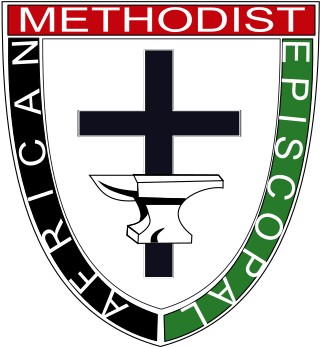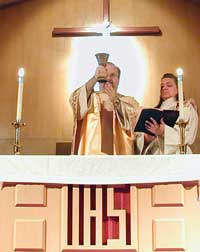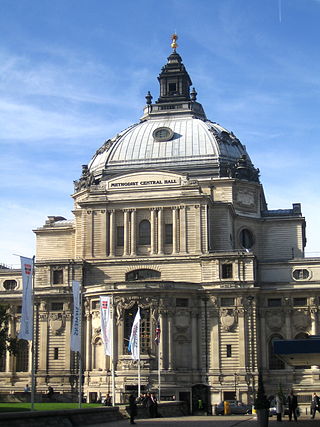| Ecclesiastical polity |
|---|
Connexionalism, also spelled connectionalism, is the theological understanding and foundation of Methodist ecclesiastical polity, as practised in the Methodist Church in Britain, Ireland, Caribbean and the Americas, United Methodist Church, Free Methodist Church, African Methodist Episcopal and Episcopal Zion churches, Bible Methodist Connection of Churches, Christian Methodist Episcopal Church, and many of the countries where Methodism was established by missionaries sent out from these churches. It refers to the way in which Methodist churches and other institutions are connected and work together to support one another, share resources, and carry out mission and ministry. The United Methodist Church defines connection as the principle that "all leaders and congregations are connected in a network of loyalties and commitments that support, yet supersede, local concerns." [1] Accordingly, the primary decision-making bodies in Methodism are conferences, which serve to gather together representatives of various levels of church hierarchy.
In the United Methodist Church and Free Methodist Church, where bishops provide church leadership, connexionalism is a variety of episcopal polity. Many Methodist churches, such as the British Methodist Church, do not have bishops. [2] In world Methodism, a given connexion (that is, denomination) is usually autonomous.
In the 18th century, "connexion" (the period spelling of connection ) referred to networks of individuals linked to a person or group, including in political, commercial, and religious spheres. [3] It was used to denote the Methodist societies connected with the person of John Wesley, and connexion remains the preferred spelling in Britain, the Commonwealth, and Ireland. "Connection" is the spelling historically used American Methodism and by groups descended from the Methodist Episcopal Church.
In the history of Christianity in England, a connexion was a circuit of prayer groups who would employ travelling ministers alongside the regular ministers attached to each congregation. This method of organizing emerged in 18th-century English nonconformist religious circles; this is why the archaic spelling (connexion rather than connection) is retained in the British church. The Countess of Huntingdon's Connexion, for instance, was founded by Selina, Countess of Huntingdon. Over time, as Methodism became a separate church, this structure of connexions came to form a new system of polity, separate from episcopal polity.
Connexional polity in Britain has always been characterized by a strong central organization which holds an annual conference. [4] The connexion is divided into districts in the charge of a chairperson. Methodist districts often correspond approximately, in geographical terms, to counties – as do Church of England dioceses. The districts are divided into circuits governed by the circuit meeting and led and administered principally by a superintendent minister. Ministers are appointed to circuits rather than to individual churches. Most notably, there are no bishops in the British connexion. [5] The term full connexion is used in Great Britain and in Ireland to refer to presbyters and deacons being "subject to the rules and discipline of the Conference of the Methodist Church", and specifically that they are subject to being stationed (i.e. appointed to ministry in a local circuit) at the direction of the conference. [6]
Free Methodist churches and United Methodist churches are generally organized on a connexional model, related but not identical to that used in Britain. Pastors are assigned to congregations by bishops, distinguishing it from presbyterian government. Methodist denominations typically give lay members representation at regional and national meetings (conferences) at which the business of the church is conducted,making it different from most episcopal government.[ citation needed ] This connexional organizational model differs further from the congregational model, for example of Baptist and Congregationalist churches.

An episcopal polity is a hierarchical form of church governance in which the chief local authorities are called bishops. The word "bishop" here is derived via the British Latin and Vulgar Latin term *ebiscopus/*biscopus, from the Ancient Greek ἐπίσκοπος epískopos meaning "overseer". It is the structure used by many of the major Christian Churches and denominations, such as the Catholic, Eastern Orthodox, Oriental Orthodox, Church of the East, Anglican, Lutheran and Methodist churches or denominations, and other churches founded independently from these lineages.
Methodism, also called the Methodist movement, is a Protestant Christian tradition whose origins, doctrine and practice derive from the life and teachings of John Wesley. George Whitefield and John's brother Charles Wesley were also significant early leaders in the movement. They were named Methodists for "the methodical way in which they carried out their Christian faith". Methodism originated as a revival movement within Anglicanism originating out of the Church of England in the 18th century and became a separate denomination after Wesley's death. The movement spread throughout the British Empire, the United States and beyond because of vigorous missionary work, and today has about 80 million adherents worldwide.
The Methodist Episcopal Church (MEC) was the oldest and largest Methodist denomination in the United States from its founding in 1784 until 1939. It was also the first religious denomination in the US to organize itself nationally. In 1939, the MEC reunited with two breakaway Methodist denominations to form the Methodist Church. In 1968, the Methodist Church merged with the Evangelical United Brethren Church to form the United Methodist Church.
The Methodist Episcopal Church, South was the American Methodist denomination resulting from the 19th-century split over the issue of slavery in the Methodist Episcopal Church (MEC). Disagreement on this issue had been increasing in strength for decades between churches of the Northern and Southern United States; in 1845 it resulted in a schism at the General Conference of the MEC held in Louisville, Kentucky.

The African Methodist Episcopal Church, usually called the AME Church or AME, is a Methodist Black church. It adheres to Wesleyan-Arminian theology and has a connexional polity. The first independent Protestant denomination to be founded by Black people, AME welcomes and has members of all ethnicities.
The Primitive Methodist Church is a Methodist Christian denomination within the holiness movement. It began in England in the early 19th century, with the influence of American evangelist Lorenzo Dow (1777–1834).
The Countess of Huntingdon's Connexion is a small society of evangelical churches, founded in 1783 by Selina Hastings, Countess of Huntingdon, as a result of the Evangelical Revival. For many years it was strongly associated with the Calvinist Methodist movement of George Whitefield.
The Methodist Church of Great Britain is a Protestant Christian denomination in Britain, and the mother church to Methodists worldwide. It participates in the World Methodist Council, and the World Council of Churches among other ecumenical associations.

Ecclesiastical polity is the government of a church. There are local (congregational) forms of organization as well as denominational. A church's polity may describe its ministerial offices or an authority structure between churches. Polity relates closely to ecclesiology, the theological study of the church.

The Methodist Church of Southern Africa (MCSA) is a large Wesleyan Methodist denomination, with local churches across South Africa, Namibia, Botswana, Lesotho and Eswatini, and a more limited presence in Mozambique. It is a member church of the World Methodist Council.

An elder, in many Methodist churches, is an ordained minister that has the responsibilities to preach and teach, preside at the celebration of the sacraments, administer the church through pastoral guidance, and lead the congregations under their care in service ministry to the world.

Selina Hastings, Countess of Huntingdon was an English Christian and religious leader who played a prominent part in the religious revival of the 18th century and the Methodist movement in England and Wales. She founded an evangelical branch in England and Sierra Leone, known as the Countess of Huntingdon's Connexion.

James O'Kelly was an American clergyman during the Second Great Awakening and an important figure in the early history of Methodism in America. He was also known for his outspoken views on abolitionism, penning the strong antislavery work, Essay on Negro Slavery.

The organisation of the Methodist Church of Great Britain is based on the principle of connexionalism. This means that British Methodism, from its inception under John Wesley (1703–1791), has always laid strong emphasis on mutual support, in terms of ministry, mission and finance, of one local congregation for another. No singular church community has ever been seen in isolation either from its immediately neighbouring church communities or from the centralised national organisation. Wesley himself journeyed around the country, preaching and establishing local worshipping communities, called "societies", often under lay leadership. Soon these local communities of worshipping Christians formalised their relationships with neighbouring Methodist communities to create "circuits", and the circuits and societies contained within them, were from the very beginning 'connected' to the centre and Methodism's governing body, the annual Conference. Today, societies are better known as local churches, although the concept of a community of worshipping Christians tied to a particular location, and subdivided into smaller cell groups called "classes", remains essentially based on Wesley's societies.
John Bennet (1714–1759) was an early Methodist Evangelist, regarded as being "one of Wesley’s most responsible helpers in Yorkshire, Lancashire and Derbyshire".
Methodist views on the ordination of women in the rite of holy orders are diverse.
The Wesleyan Methodist Church was the majority Methodist movement in England following its split from the Church of England after the death of John Wesley and the appearance of parallel Methodist movements.
The Allegheny Wesleyan Methodist Connection (AWMC), originally the Wesleyan Methodist Church (Allegheny Conference), and also known as the Wesleyan Methodist Church (WMC), is a Methodist denomination within the conservative holiness movement. It is primarily based in the United States, with missions in Peru, Ghana, and Haiti. The Allegheny Wesleyan Methodist Connection is currently led by Rev. David Blowers (President) and Rev. Joseph Smith (Vice President).

The history of Methodism in the United States dates back to the mid-18th century with the ministries of early Methodist preachers such as Laurence Coughlan and Robert Strawbridge. Following the American Revolution most of the Anglican clergy who had been in America came back to England. John Wesley, the founder of Methodism, sent Thomas Coke to America where he and Francis Asbury founded the Methodist Episcopal Church, which was to later establish itself as the largest denomination in America during the 19th century.
The Bible Methodist Connection of Churches is a Methodist denomination within the conservative holiness movement. The connection is divided into four regional conferences: the Southern Conference, led by Rev. John Parker; the Southwest Conference, led by Rev. G. Clair Sams; the Heartland Conference, led by Rev. Chris Cravens; and the Great Lakes Conference, led by Rev. David Ward.